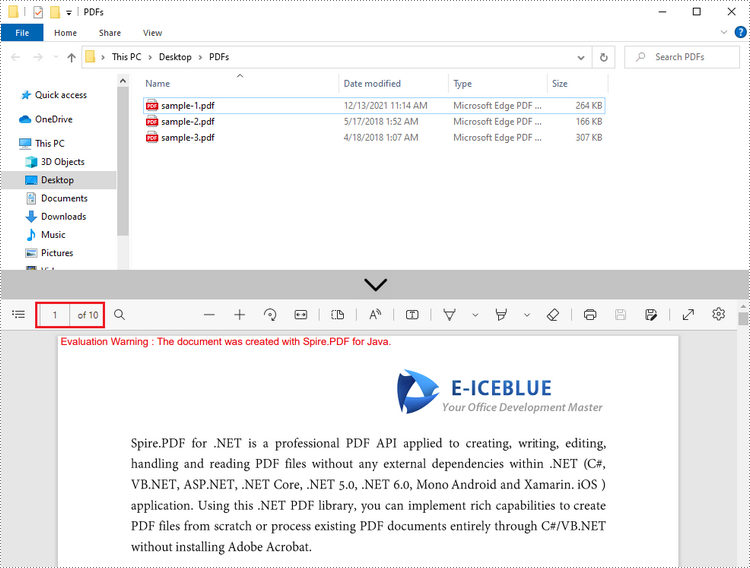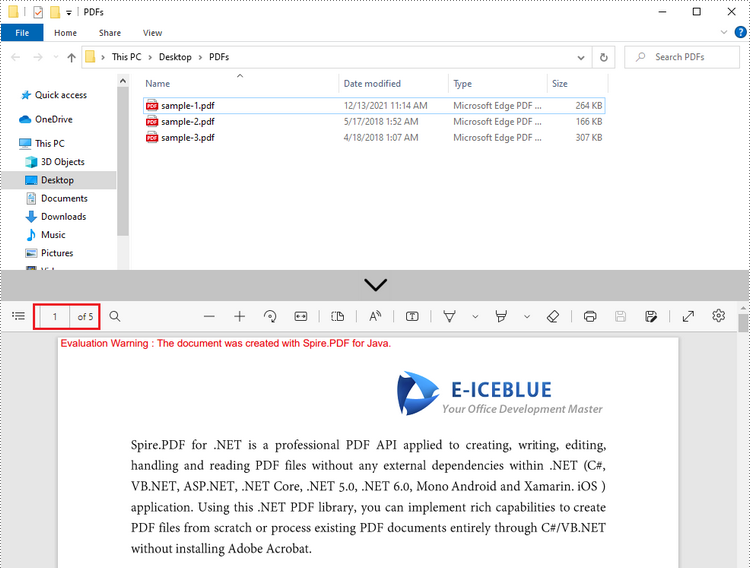
Merging PDFs in Java is a critical requirement for document-intensive applications, from consolidating financial reports to automating archival systems. However, developers face significant challenges in preserving formatting integrity or managing resource efficiency across diverse PDF sources. Spire.PDF for Java provides a robust and straightforward solution to streamline the PDF merging task.
This comprehensive guide explores how to combine PDFs in Java, complete with practical examples to merge multiple files, selected pages, or stream-based merging.
- Setting Up the Java PDF Merge Library
- Merge Multiple PDF Files in Java
- Merge Specific Pages from Multiple PDFs in Java
- Merge PDF Files by Streams in Java
- Conclusion
- FAQs
Setting Up the Java PDF Merge Library
Why Choose Spire.PDF for Java?
- No External Dependencies: Pure Java implementation.
- Rich Features: Merge, split, encrypt, and annotate PDFs.
- Cross-Platform: Works on Windows, Linux, and macOS.
Installation
Before using Spire.PDF for Java, you need to add it to your project.
Option 1: Maven
Add the repository and dependency to pom.xml:
<repositories>
<repository>
<id>com.e-iceblue</id>
<name>e-iceblue</name>
<url>https://repo.e-iceblue.com/nexus/content/groups/public/</url>
</repository>
</repositories>
<dependencies>
<dependency>
<groupId>e-iceblue</groupId>
<artifactId>spire.pdf</artifactId>
<version>11.11.11</version>
</dependency>
</dependencies>
Option 2: Manual JAR
Download the JAR from the E-iceblue website and add it to your project's build path.
Merge Multiple PDF Files in Java
This example is ideal when you want to merge two or more PDF documents entirely. It’s simple, straightforward, and perfect for batch processing.
How It Works:
- Define File Paths: Create an array of strings containing the full paths to the source PDFs.
- Merge Files: The mergeFiles() method takes the array of paths, combines the PDFs, and returns a PdfDocumentBase object representing the merged file.
- Save the Result: The merged PDF is saved to a new file using the save() method.
Java code to combine PDFs:
import com.spire.pdf.FileFormat;
import com.spire.pdf.PdfDocument;
import com.spire.pdf.PdfDocumentBase;
public class MergePdfs {
public static void main(String[] args) {
// Get the paths of the PDF documents to be merged
String[] files = new String[] {"sample-1.pdf", "sample-2.pdf", "sample-3.pdf"};
// Merge these PDF documents
PdfDocumentBase pdf = PdfDocument.mergeFiles(files);
// Save the merged PDF file
pdf.save("MergePDF.pdf", FileFormat.PDF);
}
}
Best For:
- Merging entire PDFs stored locally.
- Simple batch operations where no page selection is needed.
Result: Combine three PDF files (a total of 10 pages) into one PDF file.

Merging PDFs often results in large file sizes. To reduce the size, refer to: Compress PDF Files in Java.
Merge Specific Pages from Multiple PDFs in Java
Sometimes, you may only want to merge specific pages from different PDFs (e.g., pages 1-3 from File A and pages 2-5 from File B). This example gives you granular control over which pages to include from each source PDF.
How It Works:
- Load PDFs: Load each source PDF into a PdfDocument object and store them in an array.
- Create a New PDF: A blank PDF document is initialized to serve as the container for merged pages.
- Insert Specific Pages:
- insertPage(): Insert a specified page into the new PDF.
- insertPageRange(): Inserts a range of pages into the new PDF.
- Save the Result: The merged PDF is saved using the saveToFile() method.
Java code to combine selected PDF pages:
import com.spire.pdf.PdfDocument;
public class MergeSelectedPages {
public static void main(String[] args) {
// Get the paths of the PDF documents to be merged
String[] files = new String[] {"sample-1.pdf", "sample-2.pdf", "sample-3.pdf"};
// Create an array of PdfDocument
PdfDocument[] pdfs = new PdfDocument[files.length];
// Loop through the documents
for (int i = 0; i < files.length; i++)
{
// Load a specific document
pdfs[i] = new PdfDocument(files[i]);
}
// Create a new PDF document
PdfDocument pdf = new PdfDocument();
// Insert the selected pages from different PDFs to the new PDF
pdf.insertPage(pdfs[0], 0);
pdf.insertPageRange(pdfs[1], 1,3);
pdf.insertPage(pdfs[2], 0);
// Save the merged PDF
pdf.saveToFile("MergePdfPages.pdf");
}
}
Best For:
- Creating custom PDFs with selected pages (e.g., extracting key sections from reports).
- Scenarios where you need to exclude irrelevant pages from source documents.
Result: Combine selected pages from three separate PDF files into a new PDF

Merge PDF Files by Streams in Java
In applications where PDFs are stored as streams (e.g., PDFs from network streams, in-memory data, or temporary files), Spire.PDF supports merging without saving files to disk.
How It Works:
- Create Input Streams: The FileInputStream objects read the raw byte data of each PDF file.
- Merge Streams: The mergeFiles() method accepts an array of streams, merges them, and returns a PdfDocumentBase object.
- Save and Clean Up: The merged PDF is saved, and all streams and documents are closed to free system resources (critical for preventing leaks).
Java code to merge PDFs via streams:
import com.spire.pdf.*;
import java.io.*;
public class mergePdfsByStream {
public static void main(String[] args) throws IOException {
// Create FileInputStream objects for each PDF document file
FileInputStream stream1 = new FileInputStream(new File("Template_1.pdf"));
FileInputStream stream2 = new FileInputStream(new File("Template_2.pdf"));
FileInputStream stream3 = new FileInputStream(new File("Template_3.pdf"));
// Initialize an array of InputStream objects containing the file input streams
InputStream[] streams = new FileInputStream[]{stream1, stream2, stream3};
// Merge the input streams into a single PdfDocumentBase object
PdfDocumentBase pdf = PdfDocument.mergeFiles(streams);
// Save the merged PDF file
pdf.save("MergePdfsByStream.pdf", FileFormat.PDF);
// Releases system resources used by the merged document
pdf.close();
pdf.dispose();
// Closes all input streams to free up resources
stream1.close();
stream2.close();
stream3.close();
}
}
Best For:
- Merging PDFs from non-file sources (e.g., network downloads, in-memory generation).
- Environments where direct file path access is restricted.
Conclusion
Spire.PDF for Java simplifies complex PDF merging tasks through its intuitive, user-friendly API. Whether you need to merge entire documents, create custom page sequences, or combine PDFs from stream sources, these examples enable efficient PDF merging in Java to address diverse document processing requirements.
To explore more features (e.g., encrypting merged PDFs, adding bookmarks), refer to the official documentation.
Frequently Asked Questions (FAQs)
Q1: Why do merged PDFs show "Evaluation Warning" watermarks?
A: The commercial version adds watermarks. Solutions:
- Request a 30-day trial license to test without any restrictions.
- Use the free version for documents ≤10 pages
Q2: How do I control the order of pages in the merged PDF?
A: The order of pages in the merged PDF is determined by the order of input files (or streams) and the pages you select. For example:
- In full-document merging, files in the input array are merged in the order they appear.
- In selective page merging, use insertPage() or insertPageRange() in the sequence you want pages to appear.
Q3: Can I merge password-protected PDFs?
A: Yes. Spire.PDF for Java supports merging encrypted PDFs, but you must provide the password when loading the file. Use the overloaded loadFromFile() method with the password parameter:
PdfDocument pdf = new PdfDocument();
pdf.loadFromFile("sample.pdf", "userPassword"); // Decrypt with password
Q4: How to merge scanned/image-based PDFs?
A: Spire.PDF handles image-PDFs like regular PDFs, but file sizes may increase significantly.


